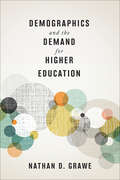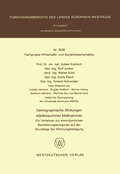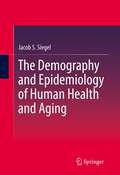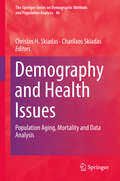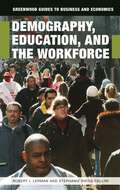- Table View
- List View
Demographic Transition, Labour Markets and Regional Resilience (Advances in Spatial Science)
by Cristina Martinez Tamara Weyman Jouke Van DijkThis book discusses the question of how a regional economy can develop under the influence of an ageing and declining population, and how regional development policies can help make labor markets more resilient and more inclusive. As the greatest impacts of demographic change and policy and fiscal challenges can be observed at the local level, examples from European, North American and Asian regions are combined to present a comprehensive, global range of strategic solutions from different policy contexts. The book shows how institutions, organizations and communities can enhance their pathways for sustainable development through the intelligent management of their demographic transition, and offers a synthesis of valuable lessons and strategies.
Demographic Transition Theory
by John C. CaldwellThis book has a strong theoretical focus and is unique in addressing both mortality and fertility over the full span of human history. It examines the demographic transition in the change in the human condition from high mortality and high fertility to low mortality and low fertility. It asks if fluctuating populations is a new phenomenon, or if there has long been an inherent tendency in Man to maximize survival and to control family size.
Demographics and Innovation in the Asia-Pacific
by Karen Eggleston, Joon-Shik Park, and Gi-Wook ShinDemographic transition, along with the economic and geopolitical re-emergence of Asia, are two of the largest forces shaping the twenty-first century, but little is known about the implications for innovation. The countries of East Asia have some of the oldest age structures on the planet: between now and 2050, the population that is age 65 and older will increase to more than one in four Chinese, and to more than one in three Japanese and Koreans. Other economies with younger populations, like India, face the challenge of fully harnessing the "demographic dividend" from large cohorts in the working ages. This book delves into how such demographic changes shape the supply of innovation and the demand for specific kinds of innovation in the Asia-Pacific. Social scientists from Asia and the United States offer multidisciplinary perspectives from economics, demography, political science, sociology, and public policy; topics range from the macroeconomic effects of population age structure, to the microeconomics of technology and the labor force, to the broader implications for human well-being. Contributors analyze how demography shapes productivity and the labor supply of older workers, as well as explore the aging population as consumers of technologies and drivers of innovations to meet their own needs, as well as the political economy of spatial development, agglomeration economies, urban-rural contrasts, and differential geographies of aging.
Demographics and the Demand for Higher Education
by Nathan D. GraweHigher education faces a looming demographic storm. Decades-long patterns in fertility, migration, and immigration persistently nudge the country toward the Hispanic Southwest. As a result, the Northeast and Midwest;¢;‚¬;€?traditional higher education strongholds;¢;‚¬;€?expect to lose 5 percent of their college-aged populations between now and the mid-2020s. Furthermore, and in response to the Great Recession, child-bearing has plummeted. In 2026, when the front edge of this birth dearth reaches college campuses, the number of college-aged students will drop almost 15 percent in just 5 years.In Demographics and the Demand for Higher Education, Nathan D. Grawe has developed the Higher Education Demand Index (HEDI), which relies on data from the 2002 Education Longitudinal Study (ELS) to estimate the probability of college-going using basic demographic variables. Analyzing demand forecasts by institution type and rank while disaggregating by demographic groups, Grawe provides separate forecasts for two-year colleges, elite institutions, and everything in between. The future demand for college attendance, he argues, depends critically on institution type. While many schools face painful contractions, for example, demand for elite schools is expected to grow by more than 15 percent in future years.Essential for administrators and trustees who are responsible for recruitment, admissions, student support, tenure practices, facilities construction, and strategic planning, this book is a practical guide for navigating coming enrollment challenges.
Demographics and the Demand for Higher Education
by Nathan D. GraweHigher education faces a looming demographic storm. Decades-long patterns in fertility, migration, and immigration persistently nudge the country toward the Hispanic Southwest. As a result, the Northeast and Midwest;¢;‚¬;€?traditional higher education strongholds;¢;‚¬;€?expect to lose 5 percent of their college-aged populations between now and the mid-2020s. Furthermore, and in response to the Great Recession, child-bearing has plummeted. In 2026, when the front edge of this birth dearth reaches college campuses, the number of college-aged students will drop almost 15 percent in just 5 years.In Demographics and the Demand for Higher Education, Nathan D. Grawe has developed the Higher Education Demand Index (HEDI), which relies on data from the 2002 Education Longitudinal Study (ELS) to estimate the probability of college-going using basic demographic variables. Analyzing demand forecasts by institution type and rank while disaggregating by demographic groups, Grawe provides separate forecasts for two-year colleges, elite institutions, and everything in between. The future demand for college attendance, he argues, depends critically on institution type. While many schools face painful contractions, for example, demand for elite schools is expected to grow by more than 15 percent in future years.Essential for administrators and trustees who are responsible for recruitment, admissions, student support, tenure practices, facilities construction, and strategic planning, this book is a practical guide for navigating coming enrollment challenges.
Demographics Unravelled: How Demographics Affect and Influence Every Aspect of Economics, Finance and Policy
by Amlan RoyDiscover what demographics can tell us about the economy, markets, and the future In Demographics Unravelled, renowned Macro-Demographics expert Amlan Roy delivers an insightful and timely exploration of the impact that “people characteristics” have on national economies. Considering factors like gender, race, migrant status, family background, and education, the author delves deeply into a subject that drives market behavior and economic variables, including growth, debt, inflation, employment, and productivity. These have national and international policy implications. In this one-of-a-kind book, you’ll discover: Why the study of demographics is the hidden key to understanding economic growth, asset prices, and capital flows How to use detailed demographics to forecast future scenarios in economics, socioeconomics, geopolitics, and the environment The short-, medium-, and long-term effects of consumer and worker behavior How understanding demographics is key to understanding health, pensions, migration, sustainability and social policies. It is intimately linked to the Sustainable Development Goals of the UN—Gender, Climate, Poverty and Inequality Perfect for institutional investors, insurance professionals, economists, and business leaders, Demographics Unravelled will also earn a place in the libraries of academics and students studying a variety of economic disciplines and seeking a one-stop and in-depth discussion of demographics-driven macroeconomic effects.
Demographics Unravelled: How Demographics Affect and Influence Every Aspect of Economics, Finance and Policy
by Amlan RoyDiscover what demographics can tell us about the economy, markets, and the future In Demographics Unravelled, renowned Macro-Demographics expert Amlan Roy delivers an insightful and timely exploration of the impact that “people characteristics” have on national economies. Considering factors like gender, race, migrant status, family background, and education, the author delves deeply into a subject that drives market behavior and economic variables, including growth, debt, inflation, employment, and productivity. These have national and international policy implications. In this one-of-a-kind book, you’ll discover: Why the study of demographics is the hidden key to understanding economic growth, asset prices, and capital flows How to use detailed demographics to forecast future scenarios in economics, socioeconomics, geopolitics, and the environment The short-, medium-, and long-term effects of consumer and worker behavior How understanding demographics is key to understanding health, pensions, migration, sustainability and social policies. It is intimately linked to the Sustainable Development Goals of the UN—Gender, Climate, Poverty and Inequality Perfect for institutional investors, insurance professionals, economists, and business leaders, Demographics Unravelled will also earn a place in the libraries of academics and students studying a variety of economic disciplines and seeking a one-stop and in-depth discussion of demographics-driven macroeconomic effects.
Demographie in der Bundesrepublik Deutschland: Vier Jahrzehnte Statistik, Forschung und Politikberatung (Schriftenreihe des Bundesinstituts für Bevölkerungsforschung BIB #18)
by Charlotte Höhn Wilfried Linke Rainer MackensenDemographische Alterung und Wirtschaftswachstum: Seminar des Bundesinstituts für Bevölkerungsforschung 1998 in Bingen (Schriftenreihe des Bundesinstituts für Bevölkerungsforschung BIB #29)
by Evelyn Grünheid Charlotte HöhnDie demographische Alterung der Gesellschaft steht als ein Schwerpunkt demographischer Forschung bereits seit langem unbestritten fest. Ob und in welchem Umfang sie allerdings auch Auswirkungen auf das Wirtschaftswachstum hat, wird seit Jahren als Bevölkerungsfrage aufgeworfen und kontrovers diskutiert. Das vom Bundesinstitut für Bevölkerungsforschung 1998 ausgerichtete Seminar bot unterschiedliche Ansätze zur Untersuchung der Auswirkungen einer alternden Gesellschaft auf relevante wirtschaftliche Bereiche. Die Thematik zieht sich dabei von den demographischen Grundlagen der Bevölkerungsalterung über Innovationsmöglichkeiten, Auswirkungen auf den Arbeitsmarkt, Aspekte der Migration, Fragen der Alters-, Kranken- und Pflegeversicherung bis hin zu finanzpolitischen Problemen des "Generational Accounting" und Auswirkungen der Alterung auf die Standortqualität Deutschlands. Dieser Band bietet eine breite Palette wissenschaftlicher Auseinandersetzung mit der Thematik "Demographische Alterung und Wirtschaftwachstum", wobei der Grundtenor skeptisch ist, und beinhaltet eine Fülle von Anregungen für Wissenschaft und Politik, um auf die Herausforderungen der demographischen Alterung für die Wirtschaftsentwicklung zu reagieren.
Demographische Analyse und populationsdynamische Modelle: Grundzüge der Bevölkerungsmathematik
by Gustav FeichtingerDemographische Trends, Bevölkerungswissenschaft und Politikberatung: Aus der Arbeit des Bundesinstituts für Bevölkerungsforschung (BiB), 1973 bis 1998 (Schriftenreihe des Bundesinstituts für Bevölkerungsforschung BIB #28)
by Charlotte HöhnJedes Jubiläum gibt Anlaß, sich des Erreichten zu vergewissern, gewissermaßen Bilanz zu ziehen. Dabei kann es nützlich sein zu bedenken, wie in den verschiedenen Zeitabschnitten die jeweilige Situation, die demographische Lage, aber auch der bevölkerungswissenschaftliche Wissensstand war. Die Mitarbeiterinnen und Mitarbeiter des Bundesinstituts für Bevölkerungsforschung (BIB) haben deshalb für die Ausarbeitung dieser Jubiläumsschrift versucht, die demographische Lage und die damit gestellten Bevölkerungsfragen vor bzw. bei Gründung des Bundesinstituts für Bevölkerungsforschung, also um 1973, dann um 1980, schließlich 1990, dem Jahr der Deutschen Einheit mit der damit übernommenen Aufgabe, die demographischen Trends in der DDR in die der neuen Länder mitzuanalysieren, und schließlich die aktuelle Lage um 1998 einschließlich der Einschätzung der zu erwartenden Bevölkerungstrends in Abschnitten zu betrachten und mit den Forschungsthemen und Veröffentlichungen des Bundesinstituts für Bevölkerungsforschung in Zusammenhang zu stellen.
Demographische Wirkungen städtebaulicher Maßnahmen: Ein Verfahren zur kleinräumlichen Bevölkerungsprognose auf der Grundlage der Wohnungsbelegung (Forschungsberichte des Landes Nordrhein-Westfalen #3028)
by Volker KreibichDemographischer Impact in städtischen Wohnquartieren: Entwicklungsszenarien und Handlungsoptionen (Quartiersforschung)
by Olaf SchnurDemography: Asia's Position In The New Global Demography (Very Short Introductions)
by Sarah HarperThe generation into which each person is born, the demographic composition of that cohort, and its relation to those born at the same time in other places influences not only a person's life chances, but also the economic and political structures within which that life is lived; the person's access to social and natural resources (food, water, education, jobs, sexual partners); and even the length of that person's life. Demography, literally the study of people, addresses the size, distribution, composition, and density of populations, and considers the impact the drivers which mediate these will have on both individual lives and the changing structure of human populations. This Very Short Introduction considers the way in which the global population has evolved over time and space. Sarah Harper discusses the theorists, theories, and methods involved in studying population trends and movements, before looking at the emergence of new demographic sub-disciplines and addressing some of the future population challenges of the 21st century. ABOUT THE SERIES: The Very Short Introductions series from Oxford University Press contains hundreds of titles in almost every subject area. These pocket-sized books are the perfect way to get ahead in a new subject quickly. Our expert authors combine facts, analysis, perspective, new ideas, and enthusiasm to make interesting and challenging topics highly readable.
The Demography and Epidemiology of Human Health and Aging
by Jacob S. SiegelWith this book, Siegel, an internationally known demographer and gerontologist, has made a unique contribution to the fledgling fields of health demography, and the demography and epidemiology of aging. The book represents a felicitous union of epidemiology, gerontology, and demography, and appears to be the first and only comprehensive text on this subject now available. Drawing on a wide range of sciences in addition to demography, gerontology, and epidemiology, including medical sociology, biostatistics, public policy, bioethics, and molecular biology, the author treats theoretical and applied issues, links methods and findings, covers the material internationally, nationally, and locally, and while focusing on the elderly, treats the entire life course. The methods, materials, and pespectives of demography and epidemiology are brought to bear on such topics as the prospects for future increases in human longevity, the relative contribution of life style, environment, genetics, and chance in human longevity, the measurement of the share of healthy years in total life expectancy, the role of population growth in the rising costs of health care, and the applications of health demography in serving the health needs of local communities. The separate chapters systematically develop the topics of the sources and quality of health data; mortality, life tables, and the measurement of health status; the interrelationships of health, on the one hand, and mortality, fertility, migration, and age structure, on the other; health conditions in the less developed countries; the concepts and theories of aging and projections of the aged population; and local health applications, public health policy, and bioethical issues in health demography. Given its comprehensiveness, clarity, interdisciplinary scope, and authencity, this book appeals to a wide range of users, from students and teachers of medical sociology, the demography of aging, and public health studies to practitioners in these areas, both as a text in health demography and the demography/epidemiology of aging, and as a reference work in these fields.
Demography and Health Issues: Population Aging, Mortality and Data Analysis (The Springer Series on Demographic Methods and Population Analysis #46)
by Christos H. Skiadas Charilaos SkiadasThis book provides new theories, applications and quantitative methods in demography, population studies and statistics. It presents and applies data analysis, statistics and stochastic modeling techniques focusing on demography, population aging, mortality and health sciences. The book describes diverse stochastic processes as well as Markov and semi-Markov models in demography and population studies, along with chapters on statistical models and methods in biostatistics and epidemiology. As such the book will be a valuable source to demographers, health scientists, statisticians, economists and sociologists.
Demography and Infrastructure: National and Regional Aspects of Demographic Change (Environment & Policy #51)
by Tobias Kronenberg and Wilhelm KuckshinrichsPopulation ageing has been going on for many decades, but population shrinking is a rather new phenomenon. The population of Germany, as in many other countries, has passed a plateau and is currently shrinking. Demographic change is a challenge for infrastructure planning due to the longevity of infrastructure capital and the need to match supply and demand in order to ensure cost-efficiency. This book summarises the findings of the INFRADEM project team, a multidisciplinary research group that worked together to estimate the effects of demographic change on infrastructure demand. Economists, engineers and geographers present studies from top-down and bottom-up perspectives, focusing on Germany and two selected regions: Hamburg and Mecklenburg-Western Pomerania. The contributors employed a broad range of methods, including an overlapping-generations model for Germany, regional input-output models, an energy systems model, and a spatial model of the transportation infrastructure.
Demography and the Global Business Environment
by Alfred A. Marcus Mazhar IslamAlfred A. Marcus and Mazhar Islam examine how demographic changes introduce new challenges for businesses, with a focus on how the world today is divided between disproportionately old and young nations. Taking a broad international perspective, the book illustrates how demography affects underlying conditions in nations, presenting the risks and opportunities for businesses as well as a set of concrete obligations they owe to the nations in which they operate.The book analyzes the key challenges that nations face based on whether they have principally old, young, or middle-aged populations, and how businesses can best respond to these challenges. Chapters particularly emphasize the impacts of immigration and technology, democratic governance, crime, corruption, and stability. Providing an in-depth examination of the relationships between youth bulges, youth busts and violence, the book grapples with the question of whether the world is likely to be a more peaceful place in the future, and the implications this could have for the global business environment.Demography and the Global Business Environment will be a valuable resource for scholars and students of international business and strategic management. It will also be highly beneficial for business leaders looking for guidance about how to evaluate the opportunities and risks of investing in various countries.
Demography at the Edge: Remote Human Populations in Developed Nations
by Rasmus Ole Rasmussen Prescott Ensign Lee HuskeyAddressing the methodological and topical challenges facing demographers working in remote regions, this book compares and contrasts the research, methods and models, and policy applications from peripheral regions in developed nations. With the emphasis on human populations as dynamic, adaptive, evolving systems, it explores how populations respond in different ways to changing environmental, cultural and economic conditions and how effectively they manage these change processes. Theoretical understandings and policy issues arising from demographic modelling are tackled including: competition for skilled workers; urbanisation and ruralisation; population ageing; the impacts of climate change; the life outcomes of Indigenous peoples; globalisation and international migration. Based on a strong theoretical framework around issues of heterogeneity, generational change, temporariness and the relative strength of internal and external ties, Demography at the Edge provides a common set of approaches and issues that benefit both researchers and practitioners.
Demography at the Edge: Remote Human Populations in Developed Nations
by Rasmus Ole Rasmussen Prescott Ensign Lee HuskeyAddressing the methodological and topical challenges facing demographers working in remote regions, this book compares and contrasts the research, methods and models, and policy applications from peripheral regions in developed nations. With the emphasis on human populations as dynamic, adaptive, evolving systems, it explores how populations respond in different ways to changing environmental, cultural and economic conditions and how effectively they manage these change processes. Theoretical understandings and policy issues arising from demographic modelling are tackled including: competition for skilled workers; urbanisation and ruralisation; population ageing; the impacts of climate change; the life outcomes of Indigenous peoples; globalisation and international migration. Based on a strong theoretical framework around issues of heterogeneity, generational change, temporariness and the relative strength of internal and external ties, Demography at the Edge provides a common set of approaches and issues that benefit both researchers and practitioners.
Demography, Education, and the Workforce (Greenwood Guides to Business and Economics)
by Robert I. Lerman Stephanie Riegg CelliniLeading experts demystify demographics and show how population changes affect everything from government policy to business opportunities to educational standards.Demographics, as Peter Drucker famously pointed out, is one of the seven sources of entrepreneurial opportunity. Why are demographics so important? Consider the quality and quantity of the U.S. labor force. Birth rates largely determine the size of the future workforce, and the numbers of younger and older people affect public spending on education. What's more, patterns in marriage and child-bearing affect the labor force, and migration and immigration alter the mix of job skills, languages, and cultures in the U.S. workforce. While business and government must react to these trends, they can also shape them. Immigration, education, welfare, and tax policies influence births, family composition, and the locations of people and businesses. In private markets, demography interacts with income levels to affect the mix of goods purchased, the types of workers in demand, and the range of new business opportunities available. Demography is a key item in every business or policy planner's toolbox. Demography, Education, and the Workforce shows how to use its principles to advantage.
Demography, Education, and the Workforce (Greenwood Guides to Business and Economics)
by Robert I. Lerman Stephanie Riegg CelliniLeading experts demystify demographics and show how population changes affect everything from government policy to business opportunities to educational standards.Demographics, as Peter Drucker famously pointed out, is one of the seven sources of entrepreneurial opportunity. Why are demographics so important? Consider the quality and quantity of the U.S. labor force. Birth rates largely determine the size of the future workforce, and the numbers of younger and older people affect public spending on education. What's more, patterns in marriage and child-bearing affect the labor force, and migration and immigration alter the mix of job skills, languages, and cultures in the U.S. workforce. While business and government must react to these trends, they can also shape them. Immigration, education, welfare, and tax policies influence births, family composition, and the locations of people and businesses. In private markets, demography interacts with income levels to affect the mix of goods purchased, the types of workers in demand, and the range of new business opportunities available. Demography is a key item in every business or policy planner's toolbox. Demography, Education, and the Workforce shows how to use its principles to advantage.
Demography for Planning and Policy: Australian Case Studies (Applied Demography Series #7)
by Tom Wilson Elin Charles-Edwards Martin BellThis edited collection shows how demographic analysis plays a pivotal role in planning, policy and funding decisions in Australia. Drawing on the latest demographic data and methods, these case studies in applied demography demonstrate that population dynamics underpin the full spectrum of contemporary social, economic and political issues. The contributors harness a range of demographic statistics and develop innovative techniques demonstrating how population dynamics influence issues such as electoral representation, the distribution of government funding, metropolitan and local planning, the provision of aged housing, rural depopulation, coastal growth, ethnic diversity and the well-being of Australia's Indigenous community. Moving beyond simple statistics, the case studies show that demographic methods and models offer crucial insights into contemporary problems and provide essential perspectives to aid efficiency, equity in public policy and private sector planning. Together the volume represents essential reading for students across the social sciences as for policy makers in government and private industry.
Demography: An Introduction to Population Studies (Springer Texts in Social Sciences)
by Richard K. ThomasThis textbook presents an overview of the field of demography from a contemporary perspective. Designed as an introductory text for undergraduates and graduates, it lays out the basic concepts, methods, and applications of the field of demography. It describes the unique characteristics of the field, reviews the basic demographic processes, and provides an overview of the analytical techniques utilized by population scientists. It emphasizes the applied nature of demography and includes a chapter on application of demography to real-world problems as well as a discussion of population policy. The text is supplemented by ample tables, graphics, and illustrations that illustrate the concepts being considered. Through including exercises as well as detailed information on the sources of demographic data, this textbook is a must have for undergraduate and graduate students in demography and population studies.
The Demography of Africa (Non-ser.)
by Bloomsbury PublishingWritten lucidly and simply to serve as an introduction to the study of the African continent from a human population perspective, this book demonstrates important factors in the ebb and flow of group size and structure using the example of the fastest growing region in the world. From a total original population of less than a quarter million in prehistoric times to the present count of 642 million people in 1990, Africa is now demonstrating an annual growth rate of 3.0%, the highest on the planet. While the rest of the world's population is expected to increase by 60%, Africa's is expected to increase by 100%, doubling by the year 2025 to a projected total of 1.6 billion people. The major factor creating the high growth rate is the drop in death rates while the fertility rates remain high. Stress on the population has been related to urbanization which has increased since African countries attained independence in the 1960s. Employment opportunities in cities are inadequate and slum conditions have appeared around most major cities. Since agriculture remains the major industry and occupation, rural development policies are seen to hold the most promise for stemming urban migration and reducing famine and poverty.



